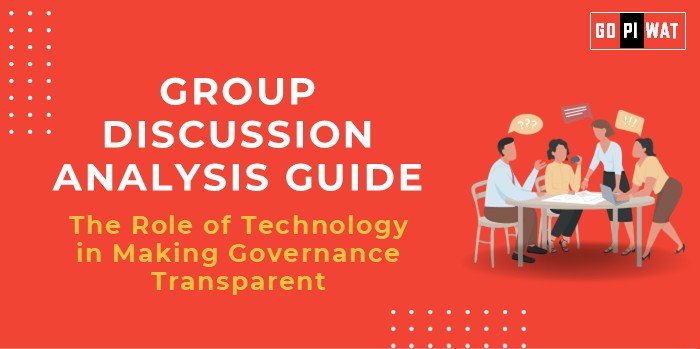📋 Group Discussion Analysis Guide
🌐 The Role of Technology in Making Governance Transparent
🌟 Introduction to the Topic
- Opening Context: Technology has revolutionized the way governments operate, making transparency and accountability achievable at an unprecedented scale. This topic holds global and national relevance as countries adopt e-governance to fight corruption and enhance citizen engagement.
- Background: From initiatives like India’s Digital India to Estonia’s e-Residency program, technology has been a cornerstone in modern governance reforms. The increasing adoption of artificial intelligence (AI), blockchain, and cloud computing promises enhanced transparency in decision-making.
📊 Quick Facts and Key Statistics
- India’s Internet Users: Over 900 million (2024) – Facilitating wide e-governance coverage.
- Digital Payments in India: ₹17.5 lakh crore monthly via UPI – Reducing corruption through transparent financial flows.
- Direct Benefit Transfers (DBT): ₹2.7 lakh crore saved through reduced leakages since implementation.
- Global Benchmark: Estonia ranks first in e-Governance, showcasing the possibilities of complete digital transparency.
👥 Stakeholders and Their Roles
- Government: Creates policies and invests in technology infrastructure.
- Technology Firms: Develop e-governance platforms and ensure cybersecurity.
- Citizens: Participate in digital governance platforms.
- International Bodies: Share best practices and provide technical support.
🏆 Achievements and Challenges
Achievements:
- Financial Transparency: UPI and DBT schemes have drastically reduced corruption.
- Public Service Efficiency: Initiatives like DigiLocker save time and paperwork.
- Citizen Participation: Platforms such as MyGov enable direct interaction between government and citizens.
- Global Leadership: India’s UPI model has inspired international adoption.
Challenges:
- Digital Divide: Rural areas still face connectivity issues with only 20% households having stable internet.
- Cybersecurity Threats: High-profile incidents like the AIIMS ransomware attack highlight vulnerabilities.
- Lack of Digital Literacy: Significant disparities exist between urban and rural populations.
🌍 Global Comparisons
- Estonia: Excels in transparent governance using blockchain.
- China: Has digitized citizen services at a vast scale.
📖 Case Studies
- Kerala Model: Digitization of 100% of public services; a leader in e-governance within India.
💬 Structured Arguments for Discussion
- Supporting Stance: “Technological innovations like UPI and blockchain are making governance more transparent and accountable.”
- Opposing Stance: “The lack of robust cybersecurity frameworks and digital literacy undermines technology’s potential in governance.”
- Balanced Perspective: “While technology has enhanced transparency, issues like the digital divide and security breaches need urgent attention.”
💡 Effective Discussion Approaches
- Opening Approaches:
- Use impactful data: “India processes more digital payments than most developed nations, but rural access remains limited.”
- Contrast urban vs. rural impact.
- Reference a specific case, such as the AIIMS cyberattack.
- Counter-Argument Handling:
- Acknowledge challenges (e.g., cybersecurity gaps).
- Propose actionable solutions like PPPs and better infrastructure.
📈 Strategic Analysis: Strengths and Weaknesses
- Strengths: Enhanced financial transparency, growing citizen participation, improved service delivery.
- Weaknesses: Infrastructure gaps, rural digital divide, security threats.
- Opportunities: AI and blockchain for greater transparency, potential for global leadership.
- Threats: Cyber attacks, political misuse of technology.
🎓 Connecting with B-School Applications
- Real-World Applications: Transparency in corporate governance; project management using digital tools.
- Sample Interview Questions:
- “How can blockchain improve governance transparency?”
- “What are the limitations of India’s digital governance model?”
- Insights for Students:
- Explore e-governance innovations.
- Analyze cybersecurity measures in governance.
- Assess the role of tech in social inclusion.


